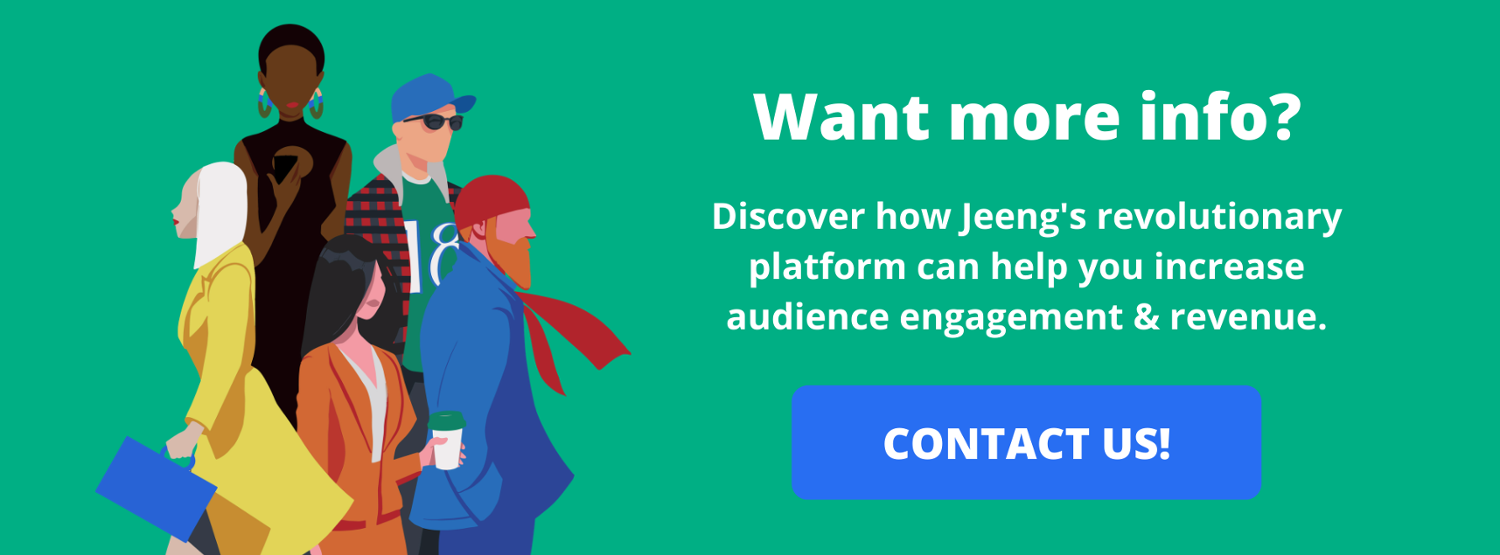In a recent Jeeng roundtable discussion with leaders in publishing and advertising, we polled the viewers asking if they were optimistic about 2021. Despite the hardships and unpredictability of 2020, a whopping 88% of viewers and participants said “yes”.
Why?
Well, even though publishers have suffered from declining ad revenue and are scrambling to prepare for the death of the third-party cookie, they have one big benefit to look forward to in all this: the opportunity to build owned audiences. Meaning, audiences they interact with and collect data from directly — outside the walled gardens of Facebook and Google.
But owned audiences aren’t built overnight. They require investments in multichannel strategies like email marketing, a strong focus on first-party data, and an emphasis on direct-to-customer models like subscriptions. With these approaches, publishers can prepare themselves for unexpected changes in the landscape in 2021 and beyond.
That’s why we’re sharing important insights from publishers across the industry about how they’re building owned audiences by driving engagement, establishing trust, and shoring up their data strategies.
Here’s what they have to say:
1. Chris Moore, head of strategic partnerships, Publishers Clearing House
“[There’s value in] direct relationships with the brand, from the brands and the publisher, but also from the publisher to the user, because there has to be some sort of value exchange that the end user is seeing from the publisher in order to give up some sort of information. And for the user to be educated enough to understand, ‘Okay, I’m giving them my email, but I’m going to have a better experience as a result.’”
2. Stephanie Layser, VP of ad tech & operations, News Corp
“Curation has been very important. […] Consumers are starting to realize, ‘Oh, these algorithms that are running our lives are not necessarily doing it in a way that is on the up-and-up.’ And we should go back to curation that’s editorially driven, whether that be us seeing a rise in Substack or a rise in newsletter subscription.”
3. Suzi Watford, CMO, The Wall Street Journal
“We have this unique role to play, not just with our core business audience who we were already seeing come to us, but also with younger readers who have perhaps been coming to the Journal for the first time. […] There is an opportunity to understand more about our customers and how we can create different products and services.”
4. Meredith Kopit Levien, COO, The New York Times
“Core to a healthy model between The Times and the platforms [we work with] is a direct path for sending those readers back into our environments, where we control the presentation of our report, the relationships with our readers, and the nature of our business rules.”
5. Jeff Kupietzky, CEO, Jeeng
“We’ve had a front-row seat to see some of this preference that consumers are showing for what we call the trusted channels — ones they’re familiar with. And email’s really been a very big recipient of that. In March, when the WHO indicated that this was going to be a pandemic, we saw an immediate spike in traffic. People are coming back to those publications that they have trusted and can be comfortable with. That has actually sustained itself all through the ebbs and flows of people adjusting to the new normal.”
6. Nola Solomon, VP of AdSmart programmatic and advanced advertising products & strategy, NBCUniversal
“As we all know, consumers are seeking out the content they crave, wherever it may be—they are agnostic to platform, time and medium. […] From a technology standpoint, it means that traditional media companies must embrace these changes and transform into a media-technology company that leverages first-party authenticated data and privacy-friendly partnerships that benefit all sides of the advertising ecosystem.”
7. Chris Park, product lead, Microsoft
“We’re really shoring up our first-party ID assets. Subscriptions could be more of a focus for us in the coming months because it’s going to align with some of the solutions that we’re deploying today, which revolve around people-based identification.”
8. Anonymous respondent in a 2019 report by Columbia Journalism Review
“It was such a bad trend where newsrooms were obsessed with ‘engagement’ and kept talking about it in terms of all these social interactions. […] I think finally publishers are looking at that word ‘engagement’ and understanding that it’s much more about a relationship with a reader. For that to exist you have got to think beyond an interaction or platform. We have to think about retention and where do I move next with this person and how do I keep in contact with this person.”
9. Amanda Dean, head of programmatic partners & strategy, IBM Watson Advertising
“[We’re] continuing our subscription journey and doing more of what our users find valuable. For us, [it’s about] just making sure the information you need is there.”
10. Jan-Willem Sanders, publisher, Follow the Money
“We have a solid base of subscribers and we know [this] makes our audience grow and keeps our churn low. We are convinced that the subscription model is future proof.”
Own your audience in 2021
As algorithms change, new platforms emerge, and consumer behaviors shift, it’s never been more important to own your audience. With direct access to your list of subscribers and readers, you can collect and manage first-party data and build one-on-one relationships.
That’s why Jeeng helps publishers tap into direct, high-engagement channels like email and push notifications — so you can stop ceding your power to third-party platforms and finally take control of your audience growth and engagement.
Ready to make it happen? Contact us today to get started.




